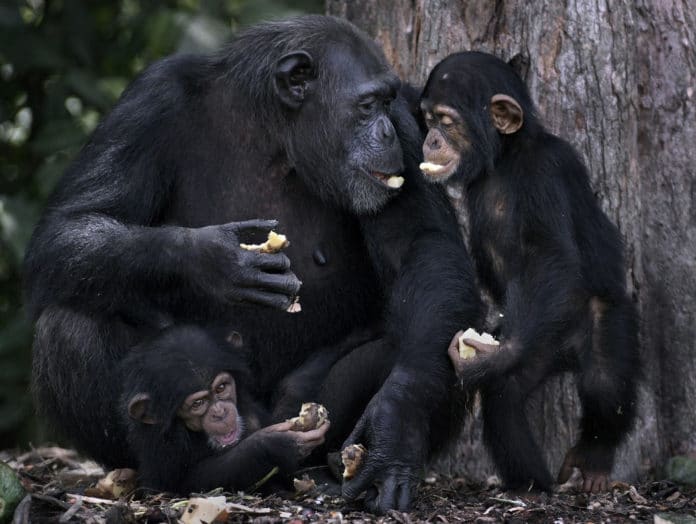Some of the chimpanzees were rejected pets. Others were captured in the wild. All of them were taken in the mid-1970s to a research laboratory in Liberia, where for decades they were infected with diseases, and their blood was drawn and tested for research that helped lead to a hepatitis B vaccine and safer blood transfusions for humans.
The New York Blood Center, a nonprofit that ran the lab, ended its research in Liberia in 2005 and retired the chimps to a collection of uninhabited mangrove islands in a river. For nearly a decade, the center supplied the animals with food and clean water, which aren’t available on the islands. Then, in 2015, as the impoverished nation staggered through an Ebola epidemic, the charity withdrew funding, saying the chimps were now the government’s responsibility.
Today, 63 chimpanzees remain on the islands, and they’re being cared for by a coalition headed by the Humane Society of the United States, which says it spends $30,000 a month paying a staff of 30, buying 500 pounds of chimp-friendly food a day, and supplying birth control to female chimps so their population does not grow. Blood center officials, meanwhile, have become the target of protesters outside their offices and homes, and of criticism from celebrities who accuse them of leaving the chimps to starve.
But the center hasn’t backed down: It says it cannot divert “millions of dollars away from our lifesaving mission” to care for chimpanzees.
This week, the Humane Society announced that it was partnering with former New Mexico governor and veteran diplomat Bill Richardson to step up what is essentially a shaming campaign to force the blood center to reconsider. Richardson, a longtime animal advocate, said his foundation was giving $35,000 to help build a chimp sanctuary on the islands – and that he would join the effort to “hold the New York Blood Center accountable for abandoning these chimps.”
The controversy over the chimpanzees has been simmering at a time when biomedical research on great apes is increasingly being abandoned. Some European countries now prohibit it. Last year, the U.S. government ended its use of chimpanzees in experiments and said it would retire them to sanctuaries, and several pharmaceutical and biotech companies have pledged to do the same. Wayne Pacelle, the Humane Society’s CEO and president, said that it is a “basic value for the research community to provide lifetime care” for the animals.
“I cannot underscore enough: They are dodging their responsibility,” Pacelle said of the New York Blood Center.
To back up that idea, activists point to the words of Alfred M. Prince, the center’s Liberia research project director, who wrote in 2005 that the blood center “recognizes its responsibility to provide an endowment to fund the Sanctuary for the lifetime care of the chimpanzees.” The blood center says on its website that that was Prince’s unauthorized opinion, and that its contracts with the Liberian Institute for Biomedical Research all made clear that the animals “were and would remain the property of the government of Liberia.”
Betsy Brotman, an American who for 35 years ran the lab, known as Vilab II, told Motherboard last year that she was shocked by this attitude. “You have to know: Vilab brought those chimps to the institute and we permitted or encouraged them to breed,” Brotman said. “This had nothing to do with the Liberian government. There were no chimps there until we put our feet there.”
Kathleen Conlee, vice president for animal research at the Humane Society, said boatloads of fruits and vegetables are tossed to the chimps once daily, but they should be fed twice a day. The organization also wants to build a sanctuary with facilities that would allow it to provide the apes with veterinary care; she said it would cost about $3 million. Twelve of the chimps are under age 10, and they can live as long as 60 years, she said.
Motherboard reported that the blood center claimed $459 million in assets in 2013, which the Humane Society contends is evidence that it can support the chimps. Pacelle said the blood center recently offered to pay 5 percent of the animals’ lifetime care costs, and amount he called “absurd.” The blood center did not respond Wednesday to a Washington Post request for information about that offer.
“If this were a struggling charity that had no resources and they were making a triage decision, at least we could understand it a little better,” Pacelle said. “Why is it okay to dump this responsibility on someone else because we care more?”
Pacelle and Richardson said they recently asked 90 of the blood center’s corporate donors in a letter to withdraw funding and condemn the center’s position on the chimps. Some donors have already done that. In March, Citibank issued a statement saying it was no longer a significant donor but believed that “the current situation is not tolerable.” MetLife, which Motherboard reported gave the blood center $250,000 in 2015, said this month that the nonprofit “should provide financial support for the care of these animals” and that it would withhold donations until “a solution is found.”






